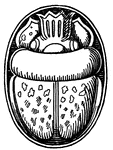
Steel Moldboard Walking Plow
Illustrated is a moldboard view of a steel moldboard walking plow. Also shown is the beam wheel.

Steel Moldboard Plow
Illustrated are the landslide and back views of a steel moldboard plow. Also shown is the subsoiling…
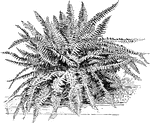
Nephrolepis Bostoniensis
Nephrolepis bostoniensis is a free growing fern with dark green, spreading leaves. It is good as a pot…

Nephrolepis Magnifica
Nephrolepis magnifica is a free grower of open habit. The leaves are erect and fifteen inches long.

Apple Tree Nursery
Pictured is a view of an American apple tree nursery. In horticulture a nursery is an establishment…

Nymphaea Tetragona
Nymphaea tetragona is a free bloomer and the smallest nymphaea in cultivation. The flowers open for…
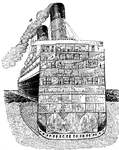
Ocean Liner
The Carmania was a ship built in 1905 built in Britain by John Brown & Company. She was designed by…

Turbine Engine
The inner workings of the Carmania. A description of how the ship gets power in order to move on the…
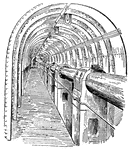
Engine Shaft
A picture of how the shafts in the Carmania are held in place. The shafts connect the engines to the…
Splicing Ear
Attachment of suspension. This particular model is used when trolley wire comes to end at a hanger.…
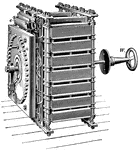
Field Rheostat
A relatively small rheostat (resistance box) that is attached to switchboard S and is operated with…
Electrolysis
How electrolysis may occur in a trolley system. TT is the trolley wire, RR is the track. As shown by…

Codling Moth
A codling moth worm, which is commonly known as a pest in the agricultural world. They are the pests…
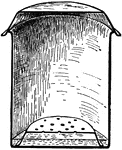
Sterilizing Pail
Sectional view of a sterilizing pail. Bottles are placed on the inverted pan on the bottom.

Second Law
An illustration of what it would look like if ball e that is placed in a cup attached to lever o were…

Simple Machine
A wheel and axle has two cylinders of different diameters that are connected so that they turn about…

Force Pump
A force pump differs from a lifting pump for many reasons, with the main reason being that the force…

Human Tooth
A sectional view of a human molar. The roots, or fangs, are shown covered by a layer of bone called…

Human Esophagus
An Image of an esophagus showing how a mass of food, or bolus, passes through the esophagus into the…
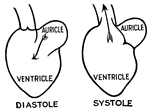
Heart Cycle
The cycle of the heart in its diastole (relaxation) state and its systole (contraction) state. The ventricles…
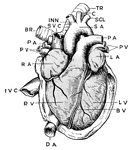
Anatomy of Heart
A complex anatomical view of the heart. RA is the right atrium, or auricle, which receives the deoxygenated…
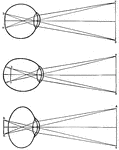
Human Eye
Diagrams of how an image is displayed with a normal eye (top image), myopic or nearsighted eye (middle…
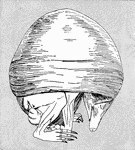
Skinned Hedgehog
A skinned hedgehog. This image is supposed to show the muscles of the back which contract to make the…
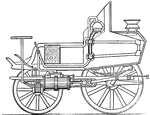
Mechanical Coach
A cross-section view of a steam powered coach. The image reveals the boiler, the cylinders, and the…

Balance Gear
As its name entails, this gear is useful at balancing out automobiles. This gear was employed often…

Propeller-Shaft Drive
A sectional view of an early model car showing a propeller shaft drive through bevel gears to the rear…
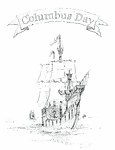
Happy Columbus Day (full page)
A full page (8.5 x 11 inches) Columbus Day illustration of the Nina, Pinta, and Santa Maria at full…

Peteler locust crushing machine
The Peteler locust crushing machine was a horse drawn device used to trap and kill locusts. Locusts…

KIng Suction Machine
The King Suction Machine was considered one of the most effective locust extermination machines of its…
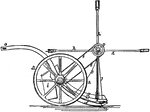
Wilson-Rhode Locust Catcher
The Wilson-Rhode locust catcher was a horse-drawn device used to trap and kill locusts. Locusts were…

The Acropolis
An image of the Acropolis, as it was, seated in Athens, Greece. The Acropolis is an ancient, famed citadel…

Smooth-coated Fox-terrier
The Fox-terrier is not an old breed, only dating back about a century; but the fox-terrier's cleverness,…
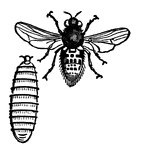
Gadfly of Sheep
The Gadfly of the sheep lays its eggs in the nostrils of the sheep. There, the maggots hatch and live…
Nerve Ganglia (Spinal)
Nerve Ganglia, or Knots (sing. Ganglion; Knot) occur as collections of nerve cells on the course of…
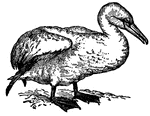
Gannet
Also known as a Solan Goose (Sula bassana), the Gannet is a large marine bird which nests in scattered…

Gauntlet
The Gauntlet is a piece of protective armor for the hand, dating back to the 12th century. The first…
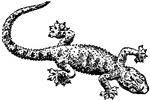
Gecko
A gecko is a small, four-footed member of the lizard family Geckonidae. Geckos are widely distributed…

Head of Gems'bok
This illustration shows a head of a Gems'bok. A Gems'bok (Oryx Gazella) is a species of South African…
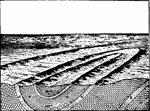
Syncline
This illustration shows a perspective view and a vertical section of a syncline. It shows the spoon-shaped…
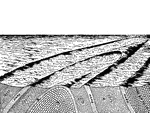
Anticline
This illustration shows a perspective view and a vertical section of an anticline. It shows the half-cigar-shaped…

Gladiators
This illustration shows various types of gladiators, each type with with his specific weapons attributed…

Stamp Mill for Gold Ores (Sectional View)
A stamp mill facilitates the crushing of ore (in this case, gold ore) into very small grains, with many…

Frue Vanner (Side View)
A Frue Vanner is a shaking, rubber belt used to concentrate gold ore 'pulp'.
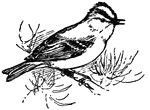
Golden-Crested Wren
Also known as the Kinglet, the Golden-Crested Wren (Regulus cristatus) is the smallest of European birds.…
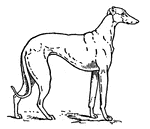
Greyhound
The Greyhound as a show dog is judged as follows: height and weight, ranging from 23 to 27 in. and from…
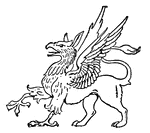
Griffin
In heraldry, the griffin is a fabulous animal, with the head and forefeet of an eagle, and the body,…

Guinea of Charles II
An English gold piece, struck during the reign of Charles II. They are called guineas because they were…

Jute
Jute, also known as Calcutta Hemp, is a fiber obtained from several species of the genus Corchorus of…

Blackwall Hitch
To tie a blackwall hitch, form a bight at the end of a rope, and put the hook of a tackle through the…






